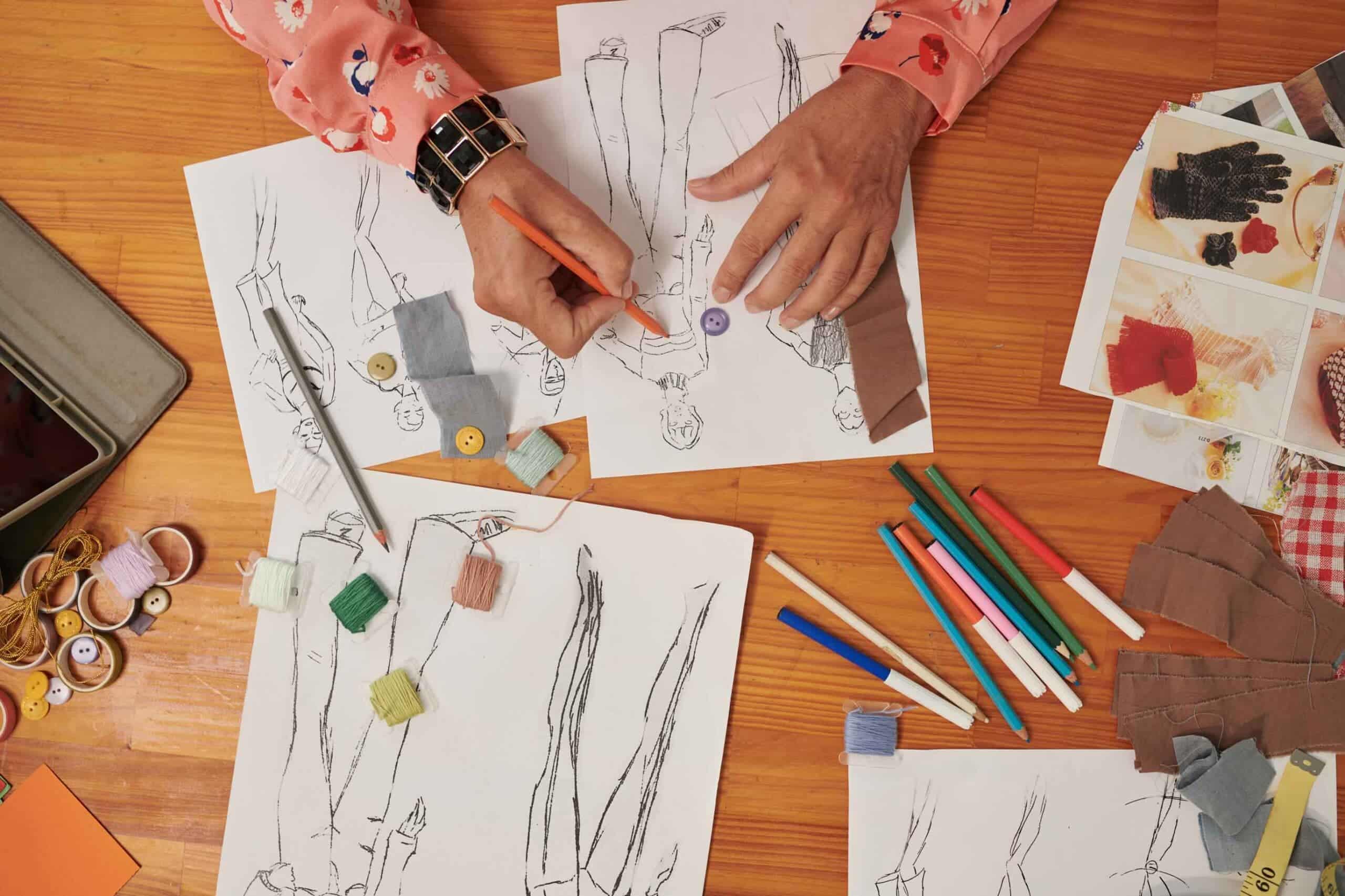If you take a glance at any of the mood boards for fashion design, you will see an array of fashion design sketches that highlight the ideas and concepts for a new line or collection. Illustrations play a central role in the fashion design process, allowing designers to sketch out their ideas and play with new concepts before bringing their vision to life.
Dive into this artistic practice below — including how fashion illustration courses and fashion design degree programs can provide you with the advanced skills needed to begin drawing fashion figures and creating fashion sketches.
The Importance of Fashion Illustration in Design
For centuries, fashion illustration has been an integral part of the fashion design process. From the time that couture fashion designers were creating bespoke outfits for aristocratic clients to the modern fashion labels of today that are designing one-of-a-kind creations for a diverse range of individuals, fashion illustration has provided designers with an opportunity to better understand the garments before they bring their vision to life.
Communicating Ideas and Concepts
When communicating design ideas, fashion illustrators and fashion designers work closely to share their thoughts and feedback on the latest collection. In other industries, communication may primarily consist of verbal conversations and written feedback, but in the fashion industry, visual communication reigns supreme. Fashion design communication relies heavily on drawings and sketches that can be reviewed, revised and revisited until the fashion concept development process is complete.
The Evolution of Fashion Illustration
While the role of fashion illustration has always been clear in the industry, techniques for completing fashion illustrations have evolved significantly over the years. At one time, fashion illustration tools consisted primarily of pencils and paper, whereas today, most fashion illustrators rely on digital sketching software to complete their illustrations.
According to the Norman Rockwell Museum’s Illustration History collection, the history of fashion illustration dates back to the Renaissance era. Most notably, the tools and techniques used to create fashion illustrations changed throughout the centuries, whereas the purpose of fashion illustrations remained the same: to communicate design ideas and showcase how fashion pieces would function in the real world.
For example, during the 19th century, fashion illustrators used fashion plates in order to quickly produce detailed illustrations that designers could send to their clients. Today, most fashion illustrators work almost exclusively with illustration technology during the fashion design collaboration process.
The Creative Process of Fashion Illustration
Combining the precision of fine art with the limitless boundaries of the fashion industry, the fashion illustration creative process provides illustrators with an opportunity to stretch their imaginations while testing out fashion design concepts in a risk-free setting. The creative process of fashion illustration involves in-depth research, endless sketching and digital refinement.
Starting With Inspiration and Research
During the initial phase of the fashion illustration process, illustrators often collaborate with fashion designers in order to better understand their ideas and goals for their next fashion design collection. Then, they begin doing their own research to bring those ideas to life.
In many cases, fashion illustrators draw upon various inspirations to create new and innovative looks for designers and fashion clients. Fashion illustration inspiration can come from a number of sources, with a couple of core categories being:
- Concrete sources (like photographs, the natural world and iconic designs of the past or a particular culture).
- Self-generated sources (like personal memories or visions).
Sketching Techniques for Fashion Design
Sketching techniques for fashion design vary greatly from one illustrator to the next. There is no right or wrong way to complete a fashion illustration, but ultimately, the illustrator will need to work closely with the designer to understand what types of sketches and images they may need for their next collection. Fashion design sketches can range from loose, minimalistic sketches to detailed renderings that include expressions and emotions. The sketching techniques utilized may vary based on the type of fashion design, target audience and designer preferences.
Using Digital Tools for Fashion Illustration
Modern fashion illustrators often lean on digital tools to complete their sketches. According to the Association of Illustrators, digital fashion sketching techniques are more efficient and sustainable because they allow illustrators to complete their work without relying on paper and ink, ultimately minimizing their carbon footprint. Digital tools for fashion illustration allow illustrators to collaborate remotely, too, preventing the need to travel to destinations in order to submit illustrations in person — which can also help reduce waste and promote sustainability in the fashion industry.
Tips for Creating Effective Fashion Sketches
As a fashion illustrator, you can enjoy freedom and flexibility in your daily work, which is perfect for creative minds who want to be able to stretch their limits and use their imaginations. However, it is essential to know how to create realistic and authentic fashion illustrations that clearly communicate your ideas and design concepts.
These fashion illustration tips can help you get started:
Proficiency in Proportions and Anatomy
When sketching fashion designs, balance and proportions play a key role in the perception of your ideas and your ability to communicate them effectively. Proportion in fashion illustration refers to the scale of the overall design, which must be relative to the size of the target customer and the design of the garment itself. If the proportion is off, the perception of your concept will be skewed. You must be proficient in human anatomy as well as bodily proportions in order to create effective and impactful fashion illustrations.
Adding Details and Textures
While the shape and structure of the garment are vital to the success of your fashion sketch, it’s also necessary to prioritize the details — such as beads that may be incorporated into a dress or buttons that accent a shirt — that add defining features to the illustration and help it stand out from other concepts. Textures can help show how the garment will move and shape itself on the client. Using digital design and sketching tools, you can seamlessly incorporate details and textures into your fashion illustrations.
Presenting Your Fashion Illustrations
As you create and complete your best fashion sketches, you will want to begin building a fashion illustration portfolio that reflects your best work. You can use this portfolio to present your fashion illustrations to fashion designers as well as couture clients, giving you an opportunity to establish your reputation as a skilled, thoughtful and creative fashion illustrator.
The Role of Fashion Illustration in the Design Process
On the surface, fashion illustrations may seem like the first step in the design process — an opportunity to sketch a few ideas on paper and see what works best for the garment. In reality, though, these illustrations are a crucial communication tool used to showcase the fit and function of a garment while giving the designer an opportunity to better understand the vision for the piece.
From Concept to Production
Initially, fashion illustrations are used to present a concept for a garment, but as a critical communication tool, these visual representations are leveraged throughout the entire fashion design process. Throughout the design and production process, fashion design collaboration takes place between all parties involved, making it so everyone may offer feedback and make revisions accordingly. The need for precise and detailed illustrations increases as the design process progresses, highlighting the importance of working with digital fashion illustration tools.
Collaborating With Clients and Teams
Fashion illustrations often serve as the go-between between fashion teams and the clients they serve. These illustrations provide fashion designers with an easy way to share concepts and ideas with their clients as well as allow clients to offer any feedback they might have. By using fashion illustrations to collaborate throughout the design process, fashion designers can better manage and meet the expectations of their clients in a way that is both sustainable and cost-effective.
Learning and Improving Fashion Illustration Skills
While fashion illustrations have been a critical part of the fashion industry for centuries, fashion illustration skills and techniques continue to change over time. The most in-demand fashion illustration skills will adapt and grow as fashion trends evolve. In a fast-moving industry like the fashion sector, it’s essential to stay informed of the latest trends and prioritize skills-based training to remain relevant in the industry.
Educational Resources and Courses
Most fashion illustrators and designers have a background in art and fashion design. In addition to earning a fashion design degree, you may want to enroll in fashion illustration courses that allow you to learn niche skills and stay informed about the latest industry trends. From conferences and webinars offered by fashion illustration industry associations to degree programs available at colleges and universities, you can find the courses and experiences that best align with your personal strengths and professional goals alike.
Staying Inspired and Current
The key to success in the fashion illustration sector, however, is to always give yourself the space to stay inspired by the world around you. Current events, evolving trends and the shifting purposes of fashion require professionals to continue refining their skills and adapting their fashion illustration approaches. Whether you are drawing fashion figures or creating mood boards for fashion design, continue to actively seek inspiration and remain aware of the changing world around you, as this will allow you to best meet the needs of the fashion designers for whom you work and the clients they serve on a daily basis.
Build Your Fashion Illustration Portfolio at Rocky Mountain College of Art + Design
Fashion illustration plays a pivotal part in the fashion design process. At Rocky Mountain College of Art + Design, we offer an on-campus Bachelor of Fine Arts in Fashion Design degree program as well as an online Bachelor of Fine Arts in Fashion Design degree program, both of which can equip you with the digital fashion illustration and fashion figure drawing skills you need to build your portfolio. Request more information about our on-campus and online programs today.

